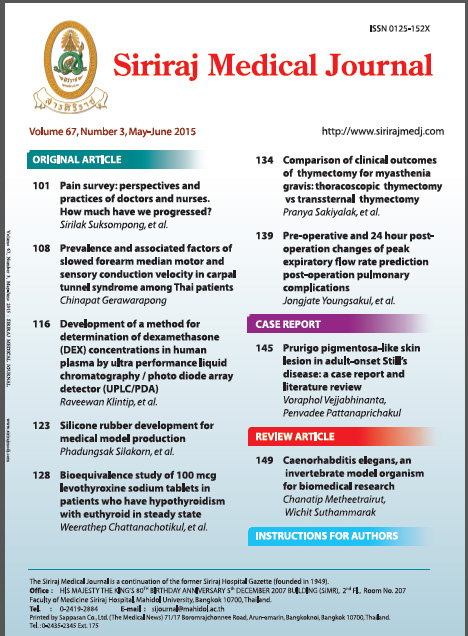Pain Survey: Perspectives and Practices of Doctors and Nurses. How Much Have We Progressed?
Abstract
Objective: To assess knowledge, current practice, and attitude of doctors and nurses toward pain management in Siriraj Hospital.
Methods: After IRB approval, a questionnaire was distributed to 300 doctors and 382 nurses working in the Departments of Anesthesiology, Medicine, Obstetrics and Gynaecology, Ophthalmology, Orthopedics, Otolaryngology, Radiology and Surgery.
Results: The response rate was 93.3% and 89.8% from doctors and nurses, respectively. Doctors (77.9%) and nurses (68.2%) replied that their aim of pain treatment was to eliminate pain without complications. The most common order for analgesics was “as needed (p.r.n.)” (61.6%). They reasoned that they thought it was appropriate (75.4%), for patient safety (60.7%), and they were trained in that way (43.9%). When the patients who had no prescription for pain asked for analgesics, 87.2% of the nurses would call the doctor to ask for medicine, and 2.9% of them would wait for the presence of doctors on the wards. There were 37.9 % of the doctors and 28.0% of the nurses who were reported to have seen patients with serious side effects (drowsiness, hypoventilation) which were usually from opioids. The common analgesics given by both doctors and nurses were paracetamol, NSAIDs, tramadol, COX-2 inhibitors, morphine and meperidine. A few doctors (5.7%) and nurses (2.9%) still believed that the pain treatment in Siriraj Hospital was inadequate. They suggested that the care could be improved by giving more education on pain medications and the methods to use them safely. This, together with changing their attitude toward the aim of pain treatment would improve patients’ need on the basis of safety.
Conclusion: Though our personnel had good attitude towards pain management, their practice seemed inadequate. Consequently, the education of both doctors and nurses should be continued.
Keywords: Attitude, pain management
Downloads
Published
How to Cite
Issue
Section
License
Authors who publish with this journal agree to the following conditions:
Copyright Transfer
In submitting a manuscript, the authors acknowledge that the work will become the copyrighted property of Siriraj Medical Journal upon publication.
License
Articles are licensed under a Creative Commons Attribution-NonCommercial-NoDerivatives 4.0 International License (CC BY-NC-ND 4.0). This license allows for the sharing of the work for non-commercial purposes with proper attribution to the authors and the journal. However, it does not permit modifications or the creation of derivative works.
Sharing and Access
Authors are encouraged to share their article on their personal or institutional websites and through other non-commercial platforms. Doing so can increase readership and citations.










